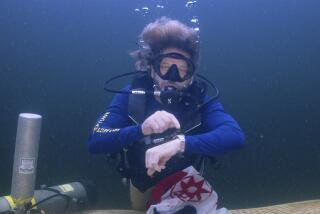Jacques Cousteau
- Share via
It was with sadness on June 26 that we heard of the death of the renowned scientist, oceanographer and author Jacques Cousteau. Cousteau visited Mission Viejo in the summer of 1981 to film a documentary series for PBS on the origin of whales. We were fortunate enough to be asked to serve as “background” for his filming, which was to take place at a location at the Upper Oso Dam in northern Mission Viejo. He was interested in the fossil evolution of whales, and because this is a rich area for marine fossils and was being intensely studied by paleontologists from the L.A. County Natural History Museum at the time, this site was chosen.
We were fortunate to have the opportunity to talk with Cousteau about our mutual interests in the fossils, and found him to be quiet, unassuming and friendly to everyone.
MARILYN MORGAN
DIANA WEIR
Mission Viejo
I do not want to detract one bit from Cousteau’s richly merited fame. But, credit should be given where it is due.
The first underwater color photographs were made in the 1920s by the American ichthyologist W.H. Longley, with the assistance of professional photographers from the staff of National Geographic magazine. Using Lumiere’s autochrome glass plates (and, because of the very low sensitivity of autochrome, some potentially lethal amounts of magnesium flash powder!), Longley made a number of color photographs off the Florida coast. Some of them were published by National Geographic in 1927, a quarter of a century or more before Cousteau and others began to publish such images.
ALAN TOMLINSON
Santa Monica
More to Read
Sign up for Essential California
The most important California stories and recommendations in your inbox every morning.
You may occasionally receive promotional content from the Los Angeles Times.












